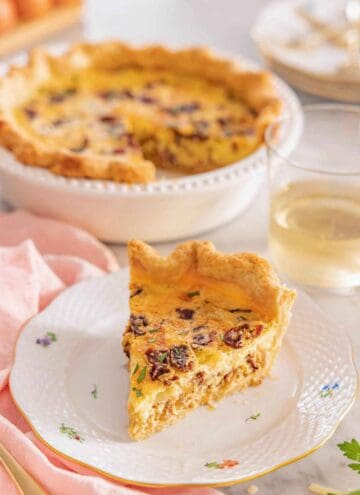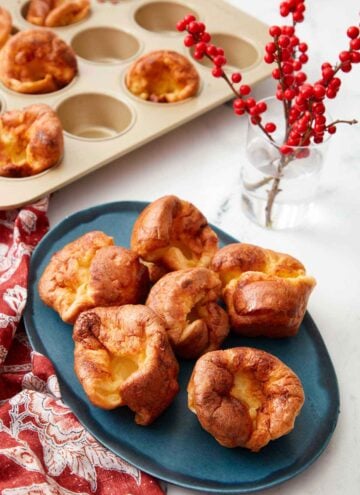If you’ve never had a Dutch baby pancake before, think of it as a cross between a crepe, a pancake, and a popover. The batter comes together quickly and easily in a blender, then poured into a sizzling hot skillet, and you’ll end up with a beautiful golden and fluffy oversized pancake that is ready in around 30 minutes.
This German pancake is such a wonderful breakfast as it’s simple enough to whip up whenever you’d like but also fancy enough for a holiday brunch! The pancake is so billowy and impressive looking when it comes out of the oven, it’s sure to turn some heads! The secret? The air whipped into the eggs when you blend the batter and using a super hot skillet and oven. Combined, you’ll get the signature rise we love to see. Want another easy breakfast recipe? Try my French toast sticks recipe, frittata recipe, or shakshuka recipe.
What You Need to Make This Recipe

Milk — I recommend using whole milk as skim or low-fat milk will lead to a less flavorful Dutch baby pancake.
Flour — all you need is all-purpose flour for the batter.
Eggs — three seems like a lot, but don’t worry, it won’t make your pancake taste eggy.
Sugar — you need two types of sugar. Granulated sugar for the batter and powdered sugar for the dusting. If you do not have powdered sugar, see my guide on how to make powdered sugar!
Vanilla — try making my homemade vanilla extract for a super flavorful vanilla extract.
Butter — I recommend using unsalted butter to prevent the pancake from tasting a little too salty.
How to Make a Dutch Baby

1. To a blender, add the milk and flour.
2. Add the eggs, sugar, vanilla, and salt to the blender.

3. Blend on high for 20 seconds.
4. Scrape down the sides of the blender and blend again for a few more seconds. Let the batter rest until the oven has reached 425F with a cast iron skillet inside.

5. Carefully remove the hot skillet from the oven. Add the butter to the skillet and swirl until melted.
6. Immediately pour the batter into the skillet. Bake for 20 minutes or until the pancake is very puffed and deep golden brown around the edges. Dust with confectioners’ sugar and serve hot, cut into wedges with fresh berries, jam, or maple syrup.

Pro Tips for Making This Recipe
- A really hot skillet is key to getting a big, puffy pancake, so don’t skip the skillet preheating. Cast iron works well because it holds the heat, but you can use any 1.5- to 2-inch deep oven-proof skillet for your Dutch baby.
- If you don’t have a blender, you can make the batter in a small food processor, using an immersion blender, or whisk vigorously by hand in a large mixing bowl.
- Bring the ingredients to room temperature before blending them together. Room temperature ingredients will blend more smoothly and help you avoid a lumpy batter. Place your eggs into a bowl of warm water for a couple of minutes. Doing so will quickly bring them to room temperature if you forget to take them out of your fridge.
- Make sure the oven is hot before adding the skillet and batter into the oven. The hotter the oven, the more puffy your Dutch baby pancake will be.
- A digital kitchen scale is the most accurate way to measure flour because adding too much flour will lead to a heavy pancake. If you do not have a scale, fluff your flour with a spoon and scoop it into your measuring cups before leveling off the top with a knife. Doing so will ensure you do not overpack the measuring cup.

Frequently Asked Questions
You can double this Dutch baby recipe! Instead of one cast iron skillet, you can use two or use a 13×9 casserole dish. Make sure to double the butter to coat the vessel you bake in as well.
You can blend the batter the night before and keep it covered in the fridge. When ready to use, bring it to room temperature and give it a quick blend again before adding it to the skillet.
Dutch baby tastes amazing when fresh. However, leftovers are still delicious! Store leftovers in the fridge in an airtight container for up to 4 days. You can reheat leftovers quickly in the microwave, or you can reheat them in the oven.
Once the German pancake is at room temperature, you can transfer it to freezer-safe bags and freeze it for up to 2 months. However, the texture will change after it thaws as you lose a lot of crispiness and its puffy texture.
Dutch Baby pancakes are derived from German Pfannkuchen (pancakes) but are actually American. The name “Dutch baby” was coined by the daughter of the owner of Manca’s Cafe in the 1900s in Seattle.
If you’ve tried this Dutch Baby recipe, then don’t forget to rate the recipe and let me know how you got on in the comments below, I love hearing from you!

Dutch Baby
Video
Equipment
- 10" cast iron skillet
- Blender
Ingredients
- ½ cup whole milk (120ml)
- ½ cup all-purpose flour (60g)
- 3 large eggs
- 2 tablespoons granulated sugar
- 1 teaspoon vanilla extract
- ¼ teaspoons salt
- 2 tablespoons unsalted butter
- Confectioners’ sugar for dusting
Instructions
- Place a 10-inch cast-iron skillet on the center oven rack and preheat the oven to 425F.
- While the oven is preheating, combine the milk, flour, eggs, sugar, vanilla, and salt in the container of a blender. Blend on high for 20 seconds, scrape down the sides of the container, and blend again for a few more seconds. Let the batter rest until the oven is hot. (This helps hydrate the flour for a fluffier, tender pancake.)
- Once preheated, blend the batter for a few seconds, then carefully remove the hot skillet from the oven. Add the butter to the skillet and swirl until melted. Immediately pour the batter into the skillet.
- Bake for 20 minutes or until the pancake is very puffed and deep golden brown around the edges. (It will shrink as it cools.) Dust with confectioners’ sugar and serve hot, cut into wedges with fresh berries, jam, or maple syrup.
Notes
- A really hot skillet is key to getting a big, puffy pancake, so don’t skip the skillet preheating. Cast iron works well because it holds the heat, but you can use any 1.5- to 2-inch deep oven-proof skillet.
- If you don’t have a blender, you can make the batter in a small food processor, using an immersion blender, or whisk vigorously by hand in a large mixing bowl.
- Bring the ingredients to room temperature before blending them together. Room temperature ingredients will blend more smoothly and help you avoid a lumpy batter. Place your eggs into a bowl of warm water for a couple of minutes. Doing so will quickly bring them to room temperature if you forget to take them out of your fridge.
- Make sure the oven is hot before adding the skillet and batter into the oven. The hotter the oven, the more puffy your Dutch baby pancake will be.
- A digital kitchen scale is the most accurate way to measure flour because adding too much flour will lead to a heavy pancake. If you do not have a scale, fluff your flour with a spoon and scoop it into your measuring cups before leveling off the top with a knife. Doing so will ensure you do not overpack the measuring cup.















Susan says
This was so easy and turned out beautifully! I made a bananas foster topping from a crepe recipe, and it was A-mazing! My son loved it! Thank you for a winning recipe!! This will be my Easter special breakfast from now on!
Juliana says
This was amazing!! Thank you John!